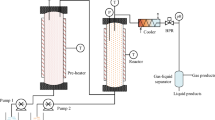Abstract
Reductive dechlorination of chlorobenzene by Fe/ZrO2 in supercritical water was investigated. The effects of the operation conditions were studied. The dechlorination of chlorobenzene obeyed pseudo-first-order kinetics models. In supercritical water, the rate constant increases more rapidly with temperature than those in subcritical water. The results showed that the rate-determining step of dechlorination in subcritical water is diffusion; whereas the rate-determining of dechlorination in supercritical water is chemical reaction. The reaction mechanism in subcritical water might involve with an ionic mechanism; whereas the reaction mechanism in supercritical water might involve with a homolytic reaction.






Similar content being viewed by others
References
Akimoto M, Tanaka H, Watanabe A (2000) Dechlorination of 1-chlorohexadecane and 2-chloronaphthalene in water under sub- and supercritical conditions. Can J Chem Eng 78:1151–1156
Broll D, Kaul C, Kramer A, Krammer P, Richter T, Jung M, Vogel H, Zehner P (1999) Chemistry in supercritical water. Angew Chem Int Ed 38:2998–3014
Cafissi A, Beduschi S, Balacco V, Sacchi B, Trasatti SP (2007) Chemical dechlorination of polychlorinated biphenyls (PCBs) from dielectric oils. Environ Chem Lett 5:101–106
Chen L, Wu YQ, Ni YH, Zhu ZB (2004) Depolymerization of polyethylene terephthalate in supercritical methanol. J Chem Eng Chin U 18:585–589
Dirk CH, Chien MW, Bernd WW (2000) Remediation of a nonachloro biphenyl congener with zero-valent iron in subcritical water. J Environ Monit 2:45–48. doi:10.1039/a908026k
Fang Z, Assaaoudi H, Sobhy A, Barsan MM, Butler IS, Kozinski JA (2008) Use of oxygen and methanol in promoting the destruction of decachlorobiphenyl in supercritical water. Fuel 87:353–358. doi:10.1016/j.fuel.2007.05.025
Kluyev N, Cheleptchikov A, Brodsky E, Soyfer V, Zhilnikov V (2002) Reductive dechlorination of polychlorinated dibenzo-p-dioxins by zerovalent iron in subcritical water. Chemosphere 46:1293–1296. doi:10.1016/S0045-6535(01)00276-4
Kubatova A, Herman J, Steckler TS, Deveij M, Miller DJ, Klunder EB, Wai CM, Hawthorne SB (2003) Subcritical (hot/liquid) water dechlorination of PCBs (Aroclor 1254) with metal additives and in waste paint. Environ Sci Technol 37:5757–5762. doi:10.1021/es030437h
Lee G, Nunoura T, Matsumura Y, Yamamoto K (2002) Effects of a sodium hydroxide addition on the decomposition of 2-chlorophenol in supercritical water. Ind Eng Chem Res 41:5427–5431. doi:10.1021/ie0108548
Marshall WL, Franck EU (1981) Ion product of water substance, 0–1,000°C, 1–10,000 bars new international formulation and its background. J Phys Chem Ref Data 10:305–566
Morlando R, Manahan SE, Larsen DW (1997) Iron-catalyzed cocurrent flow destruction and dechlorination of chlorobenzene during gasification. Environ Sci Technol 31:409–415. doi:10.1021/es960226v
Schrick B, Blough JL, Jones AD, Mallouk TE (2002) Hydrodechlorination of trichloroethylene to hydrocarbons using bimetallic nickel–iron nanoparticles. Chem Mater 14:5140–5147. doi:10.1021/cm020737i
Shoji D, Sugimoto K, Uchida H, Itatani K, Fujie M, Koda S (2005) Visualized kinetic aspects of decomposition of a wood block in sub- and supercritical water. Ind Eng Chem Res 44:2975–2981. doi:10.1021/ie040263s
Tanabe K, Holderich WF (1999) Industrial application of solid acid–base catalysts. Appl Catal Gen 181:399–434. doi:10.1016/S0926-860X(98)00397-4
Wei GT, Wei CH, He FM, Wu CF (2009) J Environ Monit. doi:10.1039/B818092J
Westacott RE, Johnston KP, Rossky PJ (2001) Stability of ionic and radical molecular dissociation pathways for reaction in supercritical water. J Phys Chem B 105:6611–6619. doi:10.1021/jp010005y
Acknowledgments
Financial supports from the National High Technology Research and Development Program of China (2006AA06Z378) and the National Natural Science Foundation of China (20777018) are sincerely acknowledged.
Author information
Authors and Affiliations
Corresponding author
Rights and permissions
About this article
Cite this article
Wei, GT., Wei, CH., Wu, CF. et al. Reductive dechlorination of chlorobenzene in supercritical water catalyzed by Fe/ZrO2 . Environ Chem Lett 8, 165–169 (2010). https://doi.org/10.1007/s10311-009-0204-3
Received:
Accepted:
Published:
Issue Date:
DOI: https://doi.org/10.1007/s10311-009-0204-3




